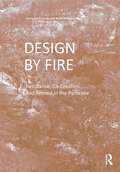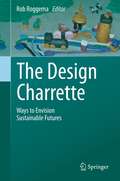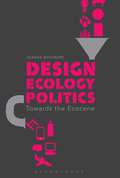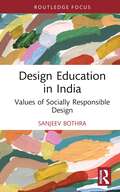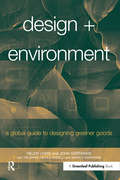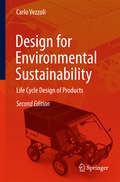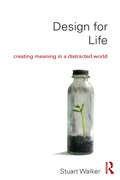- Table View
- List View
Design by Fire: Resistance, Co-Creation and Retreat in the Pyrocene
by Emily Schlickman Brett MilliganAcross the world, the risks of wildfires are increasing and expanding. Due to past and current human actions, we dwell in the age of fire – the Pyrocene – and the many challenges and climate adaptation questions it provokes. Exploring our past and current relationships with fire, this book speculates on the pyro futures yet to be designed and cared for.Drawing upon fieldwork, mapping, drone imagery, and interviews, this publication curates 27 global design case studies within the vulnerable and dynamic wildland-urban interface and its adjacent wildlands. The book catalogs these examples into three approaches: those that resist the creative and transformative power of fire and forces of landscape change, those that embrace and utilize those forces, and those that intentionally try to retreat and minimize human intervention in fire-prone landscapes. Rather than serving as a book of neatly packaged solutions, it is a book of techniques to be considered, tested, and evaluated in a time of fire.
Design by Fire: Resistance, Co-Creation and Retreat in the Pyrocene
by Emily Schlickman Brett MilliganAcross the world, the risks of wildfires are increasing and expanding. Due to past and current human actions, we dwell in the age of fire – the Pyrocene – and the many challenges and climate adaptation questions it provokes. Exploring our past and current relationships with fire, this book speculates on the pyro futures yet to be designed and cared for.Drawing upon fieldwork, mapping, drone imagery, and interviews, this publication curates 27 global design case studies within the vulnerable and dynamic wildland-urban interface and its adjacent wildlands. The book catalogs these examples into three approaches: those that resist the creative and transformative power of fire and forces of landscape change, those that embrace and utilize those forces, and those that intentionally try to retreat and minimize human intervention in fire-prone landscapes. Rather than serving as a book of neatly packaged solutions, it is a book of techniques to be considered, tested, and evaluated in a time of fire.
The Design Charrette: Ways to Envision Sustainable Futures
by Rob RoggemaThis book was written to support community involvement in the design process, to help prevent negative outcomes that can result from a top-down design approach. The combination of community involvement and design is, at least in literature, not very extensive. Although much has been written about stakeholder involvement, this is often not directly related to design processes, which – most importantly – deprives community members of the opportunity to design their desired future themselves. The Design Charrette: Ways to Envision Sustainable Futures provides a theoretical foundation establishing the benefits of organizing a design charrette for community-based planning, supported by many practical examples. The book includes sections on collaborative learning, practical guidance, theory and case studies in many different contexts: long and short charrettes, urban and rural subjects, and Dutch, Chinese, Australian, Indian and European examples. Part I: General Theory offers a detailed overview of the charrette process, a chapter on innovations in organizational and community learning and a chapter on shifting paradigms in the design charrette. Part II presents a number of case studies, including the INternational Conference on Renewable Energy Approaches for the Spatial Environment (INCREASE); charrettes accomplished in two days in the communities of Sea Lake and Bendigo in Australia; a chapter on lessons for the future, describing rural participatory design in Rajasthan, India; a description of learning by practice in a high-pressure student atelier; a chapter entitled Design Charrettes for Sustainable Building in China and more. The Design Charrette challenges the conventional wisdom that good design by itself will bring about the benefits the designer envisions. By demonstrating and analyzing the effectiveness of design charrettes in personal development and learning, and as a way to share desired future pathways, the book benefits everyone who may be leading, considering or participating in a design charrette.
Design, Ecology, Politics: Towards the Ecocene
by Joanna BoehnertDesign, Ecology, Politics links social and ecological theory to design theory and practice, critiquing the ways in which the design industry perpetuates unsustainable development.Boehnert argues that when design does engage with issues of sustainability, this engagement remains shallow, due to the narrow basis of analysis in design education and theory. The situation is made more severe by design cultures which claim to be apolitical. Where design education fails to recognise the historical roots of unsustainable practice, it reproduces old errors. New ecologically informed design methods and tools hold promise only when incorporated into a larger project of political change. Design, Ecology, Politics describes how ecological literacy challenges many central assumptions in design theory and practice.By bringing design, ecology and socio-political theory together, Boehnert describes how power is constructed, reproduced and obfuscated by design in ways which often cause environmental harms. She uses case studies to illustrate how communication design functions to either conceal or reveal the ecological and social impacts of current modes of production. The transformative potential of design is dependent on deep-reaching analysis of the problems design attempts to address. Ecologically literate and critically engaged design is a practice primed to facilitate the creation of viable, sustainable and just futures. With this approach, designers can make sustainability not only possible, but attractive.
Design, Ecology, Politics: Towards the Ecocene
by Joanna BoehnertDesign, Ecology, Politics links social and ecological theory to design theory and practice, critiquing the ways in which the design industry perpetuates unsustainable development.Boehnert argues that when design does engage with issues of sustainability, this engagement remains shallow, due to the narrow basis of analysis in design education and theory. The situation is made more severe by design cultures which claim to be apolitical. Where design education fails to recognise the historical roots of unsustainable practice, it reproduces old errors. New ecologically informed design methods and tools hold promise only when incorporated into a larger project of political change. Design, Ecology, Politics describes how ecological literacy challenges many central assumptions in design theory and practice.By bringing design, ecology and socio-political theory together, Boehnert describes how power is constructed, reproduced and obfuscated by design in ways which often cause environmental harms. She uses case studies to illustrate how communication design functions to either conceal or reveal the ecological and social impacts of current modes of production. The transformative potential of design is dependent on deep-reaching analysis of the problems design attempts to address. Ecologically literate and critically engaged design is a practice primed to facilitate the creation of viable, sustainable and just futures. With this approach, designers can make sustainability not only possible, but attractive.
Design Education in India: Values of Socially Responsible Design (Routledge Research in Social Design)
by Sanjeev BothraThis book traces developments in design education in India and shows the continuing impact of the Bauhaus School of design education, which formed the basis of the National Institute of Design. It presents the findings of the author's research and experiential learning as a design educator over a 25-year period. This book argues that as the effects of climate change and the exploitation of natural and human resources become more pervasive, it has become increasingly important to ensure that the values of social responsibility are instilled into the design students who will become future practitioners. This book offers an alternative model of understanding regarding the ecosystem of design and sustainable design education. Going beyond description and analysis, it includes three case studies of adoptable design curricula created by the author, with student responses to the programmes to provide first-hand insights into their impact. Research findings are based on detailed interviews with contemporary faculty members, all experts in the various design disciplines, along with an in-depth survey of existing design programmes in India. Design Education in India encourages a paradigm shift in thinking about the environment, spaces and places. It offers a unique perspective on the status of design education in an important and fast-growing economy and will be a useful read for design educators and researchers in varied disciplines.
Design Education in India: Values of Socially Responsible Design (Routledge Research in Social Design)
by Sanjeev BothraThis book traces developments in design education in India and shows the continuing impact of the Bauhaus School of design education, which formed the basis of the National Institute of Design. It presents the findings of the author's research and experiential learning as a design educator over a 25-year period. This book argues that as the effects of climate change and the exploitation of natural and human resources become more pervasive, it has become increasingly important to ensure that the values of social responsibility are instilled into the design students who will become future practitioners. This book offers an alternative model of understanding regarding the ecosystem of design and sustainable design education. Going beyond description and analysis, it includes three case studies of adoptable design curricula created by the author, with student responses to the programmes to provide first-hand insights into their impact. Research findings are based on detailed interviews with contemporary faculty members, all experts in the various design disciplines, along with an in-depth survey of existing design programmes in India. Design Education in India encourages a paradigm shift in thinking about the environment, spaces and places. It offers a unique perspective on the status of design education in an important and fast-growing economy and will be a useful read for design educators and researchers in varied disciplines.
Design Energy Simulation for Architects: Guide to 3D Graphics
by Kjell AndersonLeading architectural firms are now using in-house design simulation to help make more sustainable design decisions. Taking advantage of these new tools requires understanding of what can be done with simulation, how to do it, and how to interpret the results. This software-agnostic book, which is intended for you to use as a professional architect, shows you how to reduce the energy use of all buildings using simulation for shading, daylighting, airflow, and energy modeling. Written by a practicing architect who specializes in design simulation, the book includes 30 case studies of net-zero buildings, as well as of projects with less lofty goals, to demonstrate how energy simulation has helped designers make early decisions. Within each case study, author Kjell Anderson mentions the software used, how the simulation was set up, and how the project team used the simulation to make design decisions. Chapters and case studies are written so that you learn general concepts without being tied to particular software. Each chapter builds on the theory from previous chapters, includes a summary of concept-level hand calculations (if applicable), and gives comprehensive explanations with graphic examples. Additional topics include simulation basics, comfort, climate analysis, a discussion on how simulation is integrated into some firms, and an overview of some popular design simulation software.
Design Energy Simulation for Architects: Guide to 3D Graphics
by Kjell AndersonLeading architectural firms are now using in-house design simulation to help make more sustainable design decisions. Taking advantage of these new tools requires understanding of what can be done with simulation, how to do it, and how to interpret the results. This software-agnostic book, which is intended for you to use as a professional architect, shows you how to reduce the energy use of all buildings using simulation for shading, daylighting, airflow, and energy modeling. Written by a practicing architect who specializes in design simulation, the book includes 30 case studies of net-zero buildings, as well as of projects with less lofty goals, to demonstrate how energy simulation has helped designers make early decisions. Within each case study, author Kjell Anderson mentions the software used, how the simulation was set up, and how the project team used the simulation to make design decisions. Chapters and case studies are written so that you learn general concepts without being tied to particular software. Each chapter builds on the theory from previous chapters, includes a summary of concept-level hand calculations (if applicable), and gives comprehensive explanations with graphic examples. Additional topics include simulation basics, comfort, climate analysis, a discussion on how simulation is integrated into some firms, and an overview of some popular design simulation software.
Design + Environment: A Global Guide to Designing Greener Goods
by Helen Lewis John Gertsakis Tim Grant Nicola Morelli Andrew SweatmanThere is a huge scarcity of good, practical resources for designers and students interested in minimizing the environmental impacts of products. Design + Environment has been specifically written to address this paucity. The book first provides background information to help the reader understand how and why design for environment (DfE) has become so critical to design, with reference to some of the most influential writers, designers and companies in the field. Next, Design + Environment provides a step-by-step approach on how to approach DfE: to design a product that meets requirements for quality, cost, manufacturability and consumer appeal, while at the same time minimising environmental impacts. The first step in the process is to undertake an assessment of environmental impacts, using life-cycle assessment (LCA) or one of the many simpler tools available to help the designer. From then on, DfE becomes an integral part of the normal design process, including the development of concepts, design of prototypes, final design and development of marketing strategies. Environmental assessment tools and strategies to reduce environmental impacts, such as the selection of appropriate materials, are then discussed. Next, some of the links between environmental problems, such as global warming, ozone depletion, water and air pollution and the everyday products we consume are considered. In order to design products with minimal environmental impact, we need to have a basic understanding of these impacts and the interactions between them. The four subsequent chapters provide more detailed strategies and case studies for particular product groups: packaging, textiles, furniture, and electrical and electronic products. Guidelines are provided for each of the critical stages of a product's life, from the selection of raw materials through to strategies for recovery and recycling. Finally, Design + Environment takes a look at some of the emerging trends in DfE that are offering us the opportunity to make a more significant reduction in environmental impacts. Both the development of more sustainable materials and technologies and the growing interest in leasing rather than selling products are examined. Design + Environment is organized as a workbook rather than an academic text. It should be read once, and then used as a key reference source. This clear and informative book will prove to be invaluable to practising designers, to course directors and their students in need of a core teaching and reference text and to all those interested in learning about the tools and trends influencing green product design. The authors have all been involved in an innovative demonstration programme called "EcoReDesign", which was developed by the Centre for Design at RMIT University with funding from the Australian government. The Centre successfully collaborated with Australian companies to improve the environmental performance of their products by following DfE principles.
Design + Environment: A Global Guide to Designing Greener Goods
by Helen Lewis John Gertsakis Tim Grant Nicola Morelli Andrew SweatmanThere is a huge scarcity of good, practical resources for designers and students interested in minimizing the environmental impacts of products. Design + Environment has been specifically written to address this paucity. The book first provides background information to help the reader understand how and why design for environment (DfE) has become so critical to design, with reference to some of the most influential writers, designers and companies in the field. Next, Design + Environment provides a step-by-step approach on how to approach DfE: to design a product that meets requirements for quality, cost, manufacturability and consumer appeal, while at the same time minimising environmental impacts. The first step in the process is to undertake an assessment of environmental impacts, using life-cycle assessment (LCA) or one of the many simpler tools available to help the designer. From then on, DfE becomes an integral part of the normal design process, including the development of concepts, design of prototypes, final design and development of marketing strategies. Environmental assessment tools and strategies to reduce environmental impacts, such as the selection of appropriate materials, are then discussed. Next, some of the links between environmental problems, such as global warming, ozone depletion, water and air pollution and the everyday products we consume are considered. In order to design products with minimal environmental impact, we need to have a basic understanding of these impacts and the interactions between them. The four subsequent chapters provide more detailed strategies and case studies for particular product groups: packaging, textiles, furniture, and electrical and electronic products. Guidelines are provided for each of the critical stages of a product's life, from the selection of raw materials through to strategies for recovery and recycling. Finally, Design + Environment takes a look at some of the emerging trends in DfE that are offering us the opportunity to make a more significant reduction in environmental impacts. Both the development of more sustainable materials and technologies and the growing interest in leasing rather than selling products are examined. Design + Environment is organized as a workbook rather than an academic text. It should be read once, and then used as a key reference source. This clear and informative book will prove to be invaluable to practising designers, to course directors and their students in need of a core teaching and reference text and to all those interested in learning about the tools and trends influencing green product design. The authors have all been involved in an innovative demonstration programme called "EcoReDesign", which was developed by the Centre for Design at RMIT University with funding from the Australian government. The Centre successfully collaborated with Australian companies to improve the environmental performance of their products by following DfE principles.
Design for a Sustainable Culture: Perspectives, Practices and Education (Routledge Studies in Culture and Sustainable Development)
by Astrid Skjerven Janne ReitanAs culture is becoming increasingly recognised as a crucial element of sustainable development, design competence has emerged as a useful tool in creating a meaningful life within a sustainable mental, cultural and physical environment. Design for a Sustainable Culture explores the relationship between sustainability, culture and the shaping of human surroundings by examining the significance and potential of design as a tool for the creation of sustainable development. Drawing on interdisciplinary case studies and investigations from Europe, North America and India, this book discusses theoretical, methodological and educational aspects of the role of design in relation to human well-being and provides a unique perspective on the interface between design, culture and sustainability. This book will appeal to researchers as well as postgraduate and undergraduate students in design and design literacy, crafts, architecture and environmental planning, but also scholars of sustainability from other disciplines who wish to understand the role and impact of design and culture in sustainable development.
Design for a Sustainable Culture: Perspectives, Practices and Education (Routledge Studies in Culture and Sustainable Development)
by Astrid Skjerven Janne ReitanAs culture is becoming increasingly recognised as a crucial element of sustainable development, design competence has emerged as a useful tool in creating a meaningful life within a sustainable mental, cultural and physical environment. Design for a Sustainable Culture explores the relationship between sustainability, culture and the shaping of human surroundings by examining the significance and potential of design as a tool for the creation of sustainable development. Drawing on interdisciplinary case studies and investigations from Europe, North America and India, this book discusses theoretical, methodological and educational aspects of the role of design in relation to human well-being and provides a unique perspective on the interface between design, culture and sustainability. This book will appeal to researchers as well as postgraduate and undergraduate students in design and design literacy, crafts, architecture and environmental planning, but also scholars of sustainability from other disciplines who wish to understand the role and impact of design and culture in sustainable development.
Design for Climate Adaptation: Proceedings of the UIA World Congress of Architects Copenhagen 2023 (Sustainable Development Goals Series)
by Billie Faircloth Maibritt Pedersen Zari Mette Ramsgaard Thomsen Martin TamkeThe book provides new perspectives from leading researchers accentuating and examining the central role of the built environment in conceiving and implementing multifaceted solutions for the complex challenges of climate change, revealing critical potentials for architecture and design to contribute in more informed and long-term ways to the urgent transition of our society. The book offers a compilation of peer-reviewed papers that uniquely connects knowledge broadly across practice and academia, from the newest technologies and methods to indigenous knowledge, community engagement, techniques for ecosystem regeneration, nature-based solutions, and more. The book is part of a series of six volumes that explore the agency of the built environment in relation to the SDGs through new research conducted by leading researchers. The series is led by editors Mette Ramsgaard Thomsen and Martin Tamke in collaboration with the theme editors: - Design for Climate Adaptation: Billie Faircloth and Maibritt Pedersen Zari- Design for Rethinking Resources: Carlo Ratti and Mette Ramsgaard Thomsen (Eds.)- Design for Resilient Communities: Anna Rubbo and Juan Du (Eds.)- Design for Health: Arif Hasan and Christian Benimana (Eds.)- Design for Inclusivity: Magda Mostafa and Ruth Baumeister (Eds.)- Design for Partnerships for Change: Sandi Hilal and Merve Bedir (Eds.)
Design for Dementia, Mental Health and Wellbeing: Co-Design, Interventions and Policy (ISSN)
by Kristina Niedderer, Geke Ludden, Tom Dening and Vjera Holthoff-DettoThis edited volume offers the first overview and reflective discussion of how design can contribute to people’s wellbeing and mental health in the context of dementia, mental illness and neurodiversity. This book explores and promotes holistic, salutogenic and preventive strategies that recognise and respond to people’s needs, wants, wishes and rights to further health, wellbeing and equality. Bringing together years of experience as designers and clinicians, the contributors to the book emphasise how design can be a collaborative, creative process as well as an outcome of this process, and they reveal how this is guided by mental health and design policy. Through its three parts, the book explores themes of ethics, citizenship and power relationships in co-design, providing an overview of current developments and approaches in co-design; of the culturally and value sensitive adaptation of design interventions and their applications, many of which are a result of co-design; and of policy and related standards in and for design and mental health. In this way, the book demonstrates how design can help to support people, their care partners and care professionals in promoting mental health and wellbeing, and it offers a rich resource on how to create a sustainable future for care in this domain. The book provides a unique and holistic overview and resource for designers, researchers, students, policy providers and health and care professionals to help support the development and adoption of person-centred design processes and interventions.
Design for Dementia, Mental Health and Wellbeing: Co-Design, Interventions and Policy (ISSN)
This edited volume offers the first overview and reflective discussion of how design can contribute to people’s wellbeing and mental health in the context of dementia, mental illness and neurodiversity. This book explores and promotes holistic, salutogenic and preventive strategies that recognise and respond to people’s needs, wants, wishes and rights to further health, wellbeing and equality. Bringing together years of experience as designers and clinicians, the contributors to the book emphasise how design can be a collaborative, creative process as well as an outcome of this process, and they reveal how this is guided by mental health and design policy. Through its three parts, the book explores themes of ethics, citizenship and power relationships in co-design, providing an overview of current developments and approaches in co-design; of the culturally and value sensitive adaptation of design interventions and their applications, many of which are a result of co-design; and of policy and related standards in and for design and mental health. In this way, the book demonstrates how design can help to support people, their care partners and care professionals in promoting mental health and wellbeing, and it offers a rich resource on how to create a sustainable future for care in this domain. The book provides a unique and holistic overview and resource for designers, researchers, students, policy providers and health and care professionals to help support the development and adoption of person-centred design processes and interventions.
Design for Environmental Sustainability: Life Cycle Design of Products
by Carlo Arnaldo VezzoliThis volume is a technical and operative contribution to the United Nations "Decade on Education for Sustainable Development" (2005-2014), aiding the development of a new generation of designers, responsible and able in the task of designing environmentally sustainable products. The book provides a comprehensive framework and a practical tool to support the design process. This is an important text for those interested in the product development processes.
Design for Fragility: 13 Stories of Humanitarian Architects
by Esther Charlesworth John FienThe demand is now urgent for architects to respond to the design and planning challenges of rebuilding cities and landscapes being destroyed by civil conflict, (un)natural disasters, political instability, and poverty. The number of people fleeing their homes and being displaced by such conflict now totals almost 100 million. Despite the massive human and physical costs of these crises, the number of architects, planners, and landscape architects equipped to work with disaster and development professionals in rebuilding in the aftermath of conflict, floods, fires, earthquakes, typhoons, and tsunamis remains chronically low. Design for Fragility expands the nascent, but rapidly growing field of humanitarian architecture by exploring 13 design responses to such conflict and displacement across 11 countries, including Australia, Bangladesh, Fiji, India, Iran, Pakistan, and the USA. Linked to this displacement is the systemic poverty that often lingers from previous colonial territories and eras, in which many of the featured projects in the book are located. This book follows Charlesworth’s Humanitarian Architecture: 15 Stories of Architects Working After Disasters (Routledge 2014), which analysed the role for architects in exercising ‘spatial agency’ while designing shelter and settlement projects for communities after conflict and disaster. Since that time, the humanitarian architecture movement has expanded globally with the prominence of design agencies including the MASS Design Group and Architecture Sans Frontières (ASF) International. Design for Fragility analyses this role of spatial agency in architecture by addressing diverse conditions of fragility across 13 built projects – from refugee housing in Uganda and an orphanage for teenage girls in Iran to a residential centre in Northern Australia for people with acquired brain injury. Each of the projects profiled in this book explore: The experiences and perceptions of fragility – or precarity – that provided a design challenge and directed the particular spatial response. The specific typology of the project, whether that be a housing, health, children’s, or a First Nations project. The personal values that influenced the architects to work on humanitarian/community projects and how consultation occurred with diverse and often contested project stakeholders. The experiences of the design team as well as project managers, occupants, and donors of the built project, exploring what they deemed successful about the project, and what, if any, were its limitations. Beautifully designed with over 150 illustrations, this practical and inspiring book is for architects, landscape architects, design educators, humanitarian and development aid agencies that are involved, or seeking to be part, of future disaster mitigation and reconstruction strategies and projects, globally.
Design for Fragility: 13 Stories of Humanitarian Architects
by Esther Charlesworth John FienThe demand is now urgent for architects to respond to the design and planning challenges of rebuilding cities and landscapes being destroyed by civil conflict, (un)natural disasters, political instability, and poverty. The number of people fleeing their homes and being displaced by such conflict now totals almost 100 million. Despite the massive human and physical costs of these crises, the number of architects, planners, and landscape architects equipped to work with disaster and development professionals in rebuilding in the aftermath of conflict, floods, fires, earthquakes, typhoons, and tsunamis remains chronically low. Design for Fragility expands the nascent, but rapidly growing field of humanitarian architecture by exploring 13 design responses to such conflict and displacement across 11 countries, including Australia, Bangladesh, Fiji, India, Iran, Pakistan, and the USA. Linked to this displacement is the systemic poverty that often lingers from previous colonial territories and eras, in which many of the featured projects in the book are located. This book follows Charlesworth’s Humanitarian Architecture: 15 Stories of Architects Working After Disasters (Routledge 2014), which analysed the role for architects in exercising ‘spatial agency’ while designing shelter and settlement projects for communities after conflict and disaster. Since that time, the humanitarian architecture movement has expanded globally with the prominence of design agencies including the MASS Design Group and Architecture Sans Frontières (ASF) International. Design for Fragility analyses this role of spatial agency in architecture by addressing diverse conditions of fragility across 13 built projects – from refugee housing in Uganda and an orphanage for teenage girls in Iran to a residential centre in Northern Australia for people with acquired brain injury. Each of the projects profiled in this book explore: The experiences and perceptions of fragility – or precarity – that provided a design challenge and directed the particular spatial response. The specific typology of the project, whether that be a housing, health, children’s, or a First Nations project. The personal values that influenced the architects to work on humanitarian/community projects and how consultation occurred with diverse and often contested project stakeholders. The experiences of the design team as well as project managers, occupants, and donors of the built project, exploring what they deemed successful about the project, and what, if any, were its limitations. Beautifully designed with over 150 illustrations, this practical and inspiring book is for architects, landscape architects, design educators, humanitarian and development aid agencies that are involved, or seeking to be part, of future disaster mitigation and reconstruction strategies and projects, globally.
Design for Good: A New Era of Architecture for Everyone
by John CaryIn this volume, the author offers character-driven, real-world stories about projects around the globe that offer more—buildings that are designed and created with and for the people who will use them. The book reveals a new understanding of the ways that design shapes our lives and gives professionals and interested citizens the tools to seek out and demand designs that dignify.
Design for Health: Proceedings of the UIA World Congress of Architects Copenhagen 2023 (Sustainable Development Goals Series)
by Arif Hasan Christian Benimana Mette Ramsgaard Thomsen Martin TamkeThe book provides new perspectives from leading researchers accentuating and examining the central role of the built environment in conceiving and implementing multifaceted solutions to the complex challenges of physical and mental health, revealing critical potentials for architecture and design to contribute in more informed and long-term ways to the urgent transition of our society. The volume book offers a compilation of peer-reviewed papers that uniquely connects knowledge and criticality broadly across practice and academia; from new technologies, theories, and methods to community -engaged practice on many scales, and more. The book is part of a series of six volumes that explore the agency of the built environment in relation to the SDGs through new research conducted by leading researchers. The series is led by editors Mette Ramsgaard Thomsen and Martin Tamke in collaboration with the theme editors: - Design for Climate Adaptation: Billie Faircloth and Maibritt Pedersen Zari- Design for Rethinking Resources: Carlo Ratti and Mette Ramsgaard Thomsen (Eds.)- Design for Resilient Communities: Anna Rubbo and Juan Du (Eds.)- Design for Health: Arif Hasan and Christian Benimana (Eds.)- Design for Inclusivity: Magda Mostafa and Ruth Baumeister (Eds.)- Design for Partnerships for Change: Sandi Hilal and Merve Bedir (Eds.)
Design for Inclusivity: Proceedings of the UIA World Congress of Architects Copenhagen 2023 (Sustainable Development Goals Series)
by Magda Mostafa Ruth Baumeister Mette Ramsgaard Thomsen Martin TamkeThe book provides new perspectives from leading experts examining the role of architects and urbanists in designing for inclusivity in our built environment. By focusing on themes of gender, race and ethnicity, ability, neurodiversity, age, poverty and socio-economy and the non-human, the book tackles the complex challenges that designers and scholars encounter and need to address in their works. The volume offers a diverse compilation of peer-reviewed papers related to architecture for inclusivity in various different formats, ranging from visual essays, argumentative papers and scholastic texts. It presents the notion of "availability", a concept which works to challenge the "othering" inherent in notions of inclusion and accessibility. In its introduction it presents a critical discourse around the challenges and potentials lying in the design for availability targeted towards a systemic change of our societies. The book is part of a series of six volumes that explore the agency of the built environment in relation to the SDGs through new research conducted by leading researchers. The series is led by editors Mette Ramsgaard Thomsen and Martin Tamke in collaboration with the theme editors: - Design for Climate Adaptation: Billie Faircloth and Maibritt Pedersen Zari - Design for Rethinking Resources: Carlo Ratti and Mette Ramsgaard Thomsen (Eds.) - Design for Resilient Communities: Anna Rubbo and Juan Du (Eds.) - Design for Health: Arif Hasan and Christian Benimana (Eds.) - Design for Inclusivity: Magda Mostafa and Ruth Baumeister (Eds.) - Design for Partnerships for Change: Sandi Hilal and Merve Bedir (Eds.)
Design for Life: Creating Meaning in a Distracted World
by Stuart WalkerStuart Walker’s design work has been described as life-changing, inspiring, disturbing and ferocious. Drawing on an extraordinarily diverse range of sources and informed by creative practice, Design for Life penetrates to the heart of modern culture and the malaise that underlies today’s moral and environmental crises. The author argues that this malaise is deep-seated and fundamental to the modern outlook. He shows how our preoccupation with technological progress, growth and the future has produced a constricted view of life – one that is both destructive and self-reinforcing. Based on over twenty-five years of scholarship and creative practice, he demonstrates the vital importance of solitude, contemplation, inner growth and the present moment in developing a different course – one that looks squarely at our current, precarious situation while offering a positive, hopeful way forward – a way that is compassionate, context-based, human scale, ethically motivated and critically creative. Design for Life is an intensely original contribution that will be essential reading for design practitioners and students. Written in a clear, accessible style, it will also appeal to a broader readership, especially anyone who is concerned with contemporary society’s rising inequalities and environmental failings and is looking for a more constructive, balanced and thoughtful direction.
Design for Life: Creating Meaning in a Distracted World
by Stuart WalkerStuart Walker’s design work has been described as life-changing, inspiring, disturbing and ferocious. Drawing on an extraordinarily diverse range of sources and informed by creative practice, Design for Life penetrates to the heart of modern culture and the malaise that underlies today’s moral and environmental crises. The author argues that this malaise is deep-seated and fundamental to the modern outlook. He shows how our preoccupation with technological progress, growth and the future has produced a constricted view of life – one that is both destructive and self-reinforcing. Based on over twenty-five years of scholarship and creative practice, he demonstrates the vital importance of solitude, contemplation, inner growth and the present moment in developing a different course – one that looks squarely at our current, precarious situation while offering a positive, hopeful way forward – a way that is compassionate, context-based, human scale, ethically motivated and critically creative. Design for Life is an intensely original contribution that will be essential reading for design practitioners and students. Written in a clear, accessible style, it will also appeal to a broader readership, especially anyone who is concerned with contemporary society’s rising inequalities and environmental failings and is looking for a more constructive, balanced and thoughtful direction.
Design for Partnerships for Change: Proceedings of the UIA World Congress of Architects Copenhagen 2023 (Sustainable Development Goals Series)
by Sandi Hilal Merve Bedir Mette Ramsgaard Thomsen Martin TamkeArchitecture has played a very important role in colonization of the society and the earth, and today we have the urgent task to crack the theory and practice of this same Architecture. We can achieve this only by working collectively towards reframing concepts that has been at the centre of a dominant universalist western knowledge creation. Rethinking and reframing the ideals of community, participation, commons, agency, design, and land, this book puts forward a collective effort to shift the centre of architectural thinking and practice, and create as many ways possible to understand our role as architects today. We acknowledge unrecognized practices by bringing back everyday-life experiences, different paths and forms of knowledge production and storytelling that inform our understanding of architecture. The book is part of a series of six volumes that explore the agency of the built environment in relation to the SDGs through new research conducted by leading researchers. The series is led by editors Mette Ramsgaard Thomsen and Martin Tamke in collaboration with the theme editors: - Design for Climate Adaptation: Billie Faircloth and Maibritt Pedersen Zari - Design for Rethinking Resources: Carlo Ratti and Mette Ramsgaard Thomsen (Eds.) - Design for Resilient Communities: Anna Rubbo and Juan Du (Eds.) - Design for Health: Arif Hasan and Christian Benimana (Eds.) - Design for Inclusivity: Magda Mostafa and Ruth Baumeister (Eds.) - Design for Partnerships for Change: Sandi Hilal and Merve Bedir (Eds.)
